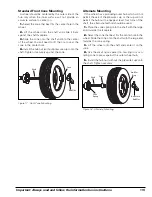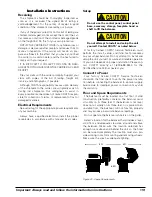
12 •
Important: Always read and follow the information box instructions.
Balancing Modes
A variety of wheel configurations can be balanced
using this wheel balancer. Read through this section, it
will help in determining which mode and options are
best suited for certain wheel assemblies. Refer to
pages 2 - 8 to balance the wheel, for measurement,
and, weight placement techniques. Refer to pages 9 -
11 for Control Panel functions.
Remember:
As with any balancing procedure, first
remove any weights attached to the wheel, inspect the
tire and wheel, and use the most appropriate balancer
mounting method before beginning.
Dynamic Modes
Choose a dynamic balance to balance a wheel using
two planes for correction. Direct Select™ the weight
option that best fits the available weight locations.
Clip-on Weights -
The default; used for most pas-
senger and light truck tire assemblies using the most
common location for corrective weights. Clip-on
weights are placed on the inner and outer rim flanges.
Have the following items handy: appropriate style
clip-on weights.
Direct Select Weight position
Clip 1
and
Clip 2
(weight LEDs illuminate). At
these locations place the corrective
weight amount at top-dead-center.
Tape-A-Weights
®
and Hidden Tape-A-Weights
®
-
Used when one or both clip-on weight locations are
not possible or desired. Select the weight location(s)
that best fits the rim configuration.
Have the following items handy: appropriate style
clip-on weights and Tape-A-Weights™.
Direct Select Weight position
Clip 1 or T1 - Tape
and
T2 - Tape, T3 - Tape or Clip 2
(LEDs illuminate). At all
locations, except T-2 Tape, place the corrective weight
amount at top-dead-center. If the T2 - Tape weight loca-
tion is selected, the balancer activates its Laser Guided
Operation™ feature (see page 7).
Static Modes
Choose a static balance for wheel assemblies that
are not possible to balance dynamically or for narrow
wheels. For example, a motorcycle wheel that has a
small wheel width.
Have the following items handy: an appropriate
wheel assembly mounted on the balancer and a selec-
tion of weights.
When in static mode,
the only active Direct
Select Weight location
is
Clip 1 or T2 - Tape
.
Select the weight location(s) that best fits the rim con-
figuration.
At the Clip 1 location, place the corrective weight
amount at top-dead-center. If the T2 - Tape weight loca-
tion is selected, the balancer activates its Laser Guided
Operation™ feature (see page 7).
EconoBalance™ Mode
EconoBalance is an alternate approach to balancing a
tire and wheel assembly. The technology seeks first to
eliminate the static imbalance in a wheel assembly
then, based on several parameters, calculates the min-
imum amount of corrective weight needed to bring
dynamic imbalance within acceptable limits.
Balancing wheel assemblies using EconoBalance
often results in the application of less corrective
weight. In addition to the potential direct savings in
wheel weights, there is a potential productivity savings
due to a reduction in the number of “re-spins” neces-
sary to achieve an acceptable balance condition.
For additional information, see Balance Options on
page 11.
Special Modes
Choose a special mode option for the following spe-
cial type wheel assemblies.
Behind Spoke (T2 - Tape Mode Only) -
Used to bal-
ance with two adhesive weights located behind the
spokes in the outer correction plane.
Only use the Direct
Select Weight position
Clip 1 or T1 - Tape
and
T2 - Tape
(LEDs illumi-
nate). When the T2 -
Tape weight location is selected, the balancer activates
its Laser Guided Operation™ feature (see page 7).





























